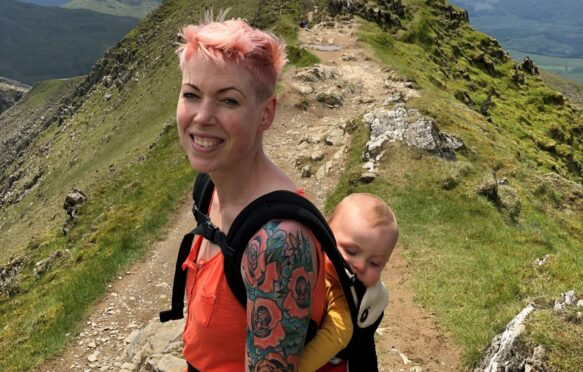
Scaling a Munro when she was three months pregnant, Helen Mort climbed guiltily, fearing every step and stumble.
Ever since she was a young girl the writer and poet had enjoyed the thrill and risk of mountain climbing, tackling peaks all over the world but now she was carrying her unborn child, she found herself forced to re-examine her pursuit of adventure as well as the way the world views women who take risks.
In her memoir A Line Above The Sky: A Story Of Mountains And Motherhood, Mort describes how she hid her bump from fellow climbers for fear of being judged.
“When I was pregnant my own sense of risk changed,” she writes. “Adventure suddenly felt like indulgence. I panted my way up Munros and covered my bump with loose waterproof jackets. I imagined the censure of every hiker I passed.”
Mort, whose book is dedicated to the memory of lost mountaineers Alison Hargreaves, 33, and her son Tom Ballard, 30, wants to champion a mother’s right to make choices for herself, even those that involve risk, without being criticised.
Mort, 37, says she is inspired by Hargreaves who in 1988 scaled the north face of the Eiger while six months pregnant with her son and later, after the birth of daughter Kate, left her family home in Fort William to become the first woman to summit Everest alone without supplementary oxygen. She later died descending K2 in 1995, her son dying on Nanga Parbat in 2019.
She said: “I have been obsessed with Alison Hargreaves and her life since I was a kid. A woman who loved the mountains, she has inspired and helped me. Whenever I am afraid I think, ‘what would Alison do?’”
The idea for the book came to Mort when, while nursing her infant son Alfie, now three, in the small hours, she heard about the death of Tom Ballard on the news.
She explained: “I would sit on the sofa feeding him, taking stock of my life and getting excited about taking him to the hills one day when I saw the news that Tom Ballard had disappeared on Nanga Parbat.
“It was like a knife to the chest. It seemed a really strong reaction and I realised it was because I was imagining if that was my son and that my way of empathizing had changed overnight because I was seeing things differently now. I wasn’t just thinking about the inspiring woman in that story – Alison – but the mother-child relationship.
“The book came from trying to make sense of that strange time of new motherhood which for some is a reconfiguring of identity but from also wanting to honour the relationship of the two people I admired who shared the mountain in life and in death.”
Mort, who lives in Sheffield with her husband, English professor Jess Edwards, says climbing mothers such as Hargreaves and herself carry a responsibility that male counterparts do not. She said: “People can be very down on those who take risks as they perceive it, especially on women.
“We judge these things by their outcomes; if someone succeeds they are seen as a hero, if someone dies they are seen as reckless. When Alison Hargreaves climbed Everest, she was a plucky mum and when she died on K2 she was ‘selfish’. Going out into the hills and needing to be in the mountains is on some level selfish.
“But that word ‘selfish’ is something women are not allowed to be – the ‘selfish mother’ in particular. There is something gendered about that word. We somehow expect men to be selfish – a typical dad going off doing his things – but women are expected to put the needs of others first.
“And Alison is challenging to that model, especially back then when the view was that you couldn’t do both. Either you were an independent woman going off and doing this stuff or you were a mother. The two were not compatible.”
But Mort pointed out: “It is important to keep your own sense of self and to be happy because if you are desperately unhappy you are not going to be a very good parent. I am interested in how you navigate those things if what makes you happy is going to the mountains.”
Although climbing is on hold for now while Mort pursues her premier passion, writing, in the first few months of his life she introduced Alfie to the wilds of the Ardnamurchan Peninsula and at three, he has already hiked three miles to the top of the Peak District’s Mam Tor.
Mort said: “He loves rock climbing already. When he is older he might want to go to Scotland with me, the way that I went with my dad to climb Munros.”
She has Torridon in her sights but confessed: “There is an unreconciled question in my head which I am no nearer to answering now than when I started writing the book, probably because it is an impossible question.
“It’s about how Alison Hargreaves would really have felt about Tom’s life in the mountains and what happened to him. I can’t help thinking that there would have been a bit of her that would have understood the drive but that also wanted to protect him. I feel she would have been delighted and afraid that he was a climber.
“All interesting writing comes from a question in yourself that you can’t quite resolve. And one of them for me is how do you let your kids take risks?”
A Line Above The Sky, by Helen Mort, is published by Ebury Press

Enjoy the convenience of having The Sunday Post delivered as a digital ePaper straight to your smartphone, tablet or computer.
Subscribe for only £5.49 a month and enjoy all the benefits of the printed paper as a digital replica.
Subscribe